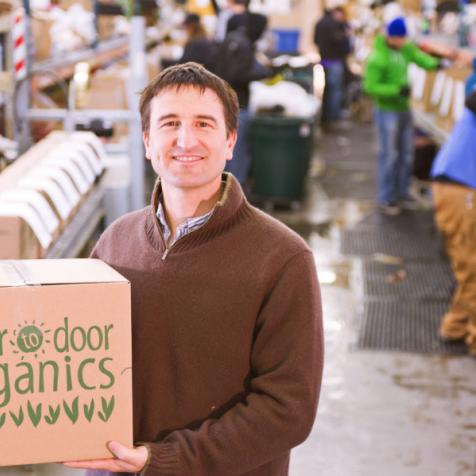
Company Details
Location
Lafayette, Colorado
Founded
1997
Ownership Type
Private
Employees
110
Products
Organic fruit products
Lafayette, Colorado
Founded: 1997
Privately owned
Employees: 267 (110 in Colorado)
Chad Arnold and Door-to-Door Organics distribute the fruits of regional producers and makers, building a unique food experience along the way
David Gersenson started Door to Door Organics in Pennsylvania in 1997 and relocated the company to Colorado in 2004.
"He built an incredible relationship with a core set of customers," says CEO Chad Arnold, who joined the company in 2009.
"I'd wondered why Internet grocery really hadn't taken hold," he says. "It was an interesting opportunity to look at an underutilized aspect of technology. How do you add value to the grocery experience that changes people's behavior?"
Only about 2 percent of the $650 billion "food at home" market is online, Arnold notes. "It's really the last great frontier in retail that hasn't embraced e-commerce."
But it's starting to gain traction, and Door to Door Organics is helping lead the way with its dynamic website. "It's not a typical shopping-cart e-commerce model," explains Arnold. "We talk a lot about 'food contextualization.' It really underlines the fact that we are different."

Arnold says many competitors take a "static" approach on their websites. Door to Door's differentiator? "We think of it as part of a customer's overall food week," he explains. "It's very iterative and very cyclical. That eating part of the cycle informs how you plan your next week. In a digital environment, you're able to connect those pieces of the cycle."
Door to Door's customers can look at their order history, caloric content and nutrition of foods, and click on recipes and automatically get all ingredients in an order. "We can match up the 10 ingredients in eggplant parmesan and connect them with one click," says Arnold. "We've built a lot of ritual into the customer experience."
Amazon didn't replace the bookstore experience, he adds. "They just gave you five different kinds of value. I think food at the end of the day is going to be the same way. There's going to be a point where people get more value online than from walking into a store."
Another Door to Door focus: good food. Arnold describes the selection as "highly curated offerings." "It's a focused set of SKUs," he says. "We don't need 40 kinds of pasta sauce when we can have eight great ones."
Foods are sourced from local producers whenever possible. About 70 percent of produce delivered in Colorado comes from Colorado farmers in the growing season. And when it's not possible -- as is often the case in winter in many areas -- the company strives to source it in the most environmentally friendly way possible.
Because Door to Door has "a lot more predictability," it loses about 5 percent less produce to rot than a traditional grocer, he adds.
Door to Door currently delivers groceries to customers in Colorado, Pennsylvania, Michigan, Kansas City, and Chicago. After launching prepared meals in Colorado in October 2013, Arnold says the company is eying several undisclosed new markets to enter in 2014.
"We look for underserved markets from an organic perspective," says Arnold. "Because we deal in low volume, we don't have to be in New York City or Los Angeles or San Francisco."
Arnold says the company is able to "artificially create density" in its routes. If you have 50 deliveries in a line or a grid, it doesn't matter. "There's still a lot of density in the route," he notes.
"We have a history of making money, and in this industry, that's unique," Arnold notes.
"We've really built a very focused customer experience and therefore have built a really focused operation to support that customer."
For 2014, Door to Door is aiming for $45 million in sales, up from about $26 million for 2013. "In the grocery world, that's like one and a half well-performing stores," says Arnold. But annual growth has tracked at 30 to 40 percent over the company's 16-year history, while the staid grocery market typically grows at 2 percent a year.

Big grocers "are letting other people figure out the complexities of their business model, then they'll buy in some day," Arnold predicts.
"We're excited about Amazon's expansion [into groceries]" in Seattle, Los Angeles, and San Francisco with its AmazonFresh service.
"It's going to wake up the rest of the grocery sector and, better for us, it's going to wake up the consumer."
Challenges: Keeping up with growth. "We have to stay extremely focused on the customer while growing at this pace," says Arnold. "It's the fundamental challenge to what we do."
Opportunities: The huge potential for online grocery sales. As the $650-billion market is now only 2 percent online, there is a lot of room to grow.
Needs: Capital. "It's starting to come into this space," says Arnold. He says the company's target number is $14 million in 2014.
